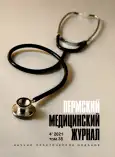Dynamics of interleukin-17 in patients with multiple sclerosis and two-phase model of disease patho-genesis
- Authors: Baidina T.V.1, Sursyakova N.V.2, Danilova M.A.1, Trushnikova T.N.1, Kuklina E.M.3
-
Affiliations:
- E.A. Vagner Perm State Medical University
- Perm Regional Clinical Hospital
- Perm Federal Research Center of the Ural Branch of the Russian Academy of Sciences
- Issue: Vol 38, No 4 (2021)
- Pages: 48-53
- Section: Original studies
- URL: https://journals.rcsi.science/PMJ/article/view/77681
- DOI: https://doi.org/10.17816/pmj38448-53
- ID: 77681
Cite item
Full Text
Abstract
Objective. To study the concentration of the pro-inflammatory cytokine interleukin-17 in the blood serum of patients with multiple sclerosis.
Materials and methods. 68 patients with multiple sclerosis were examined. The severity of neurological deficit was assessed by EDSS and MSFC. The concentration of interleukin-17 in the blood serum was determined by the method of enzyme-linked immunosorbent assay.
Results. It was found that in patients with multiple sclerosis, the concentration of interleukin-17 in the blood serum, normal in the group as a whole, was induced by the effect of immunomodulatory therapy as well as the decrease in the activity of inflammatory processes with an increase in the duration of disease.
Conclusions. It was found that MDDMS therapy is most effective in the early stages of the disease; in the later stages, activities associated with neurotrophic support play a special role.
Keywords
Full Text
##article.viewOnOriginalSite##About the authors
T. V. Baidina
E.A. Vagner Perm State Medical University
Email: m.a.danilova82@mail.ru
MD, PhD, Professor, Department of Neurology and Medical Genetics
Russian Federation, PermN. V. Sursyakova
Perm Regional Clinical Hospital
Email: m.a.danilova82@mail.ru
physician, Neurological Unit
Russian Federation, PermM. A. Danilova
E.A. Vagner Perm State Medical University
Author for correspondence.
Email: m.a.danilova82@mail.ru
Candidate of Medical Sciences, Associate Professor, Department of Neurology and Medical Genetics
Russian Federation, PermT. N. Trushnikova
E.A. Vagner Perm State Medical University
Email: m.a.danilova82@mail.ru
Candidate of Medical Sciences, Assistant, Department of Neurology and Medical Genetics
Russian Federation, PermE. M. Kuklina
Perm Federal Research Center of the Ural Branch of the Russian Academy of Sciences
Email: m.a.danilova82@mail.ru
Doctor of Biological Sciences, senior researcher
Russian Federation, PermReferences
- Kicherova O.A., Reykhert L.I., Revnivykh M.Yu. Neurodegeneration in multiple sclerosis and methods of its correction. Akademicheskiy zhurnal Zapadnoy Sibiri 2019; 15 (4–81): 46–47 (in Russian).
- Trushnikova T.N., Medvedeva E.L., Baydina T.V., Danilova M.A. Brain and ciliary neurotrophic factors in patients with multiple sclerosis. Journal of Neurology and Psychiatry C.C. Korsakov 2014; 114 (10–2): 33–36 (in Russian).
- Shmidt T.E. Neurodegeneration in multiple sclerosis and the neuroprotective effect of glatiramer acetate (literature review). Journal of Neurology and Psychiatry C.C. Korsakov. Special issues 2012; 112 (9–2): 123–128 (in Russian).
- Beringer A., Noack M., Miossec P.IL-17 in Chronic Inflammation: From Discovery to Targeting. Trends in Molecular Medicine 2016; 22 (3): 230–241.
- Dendrou C.A., Fugger L. Friese M.A. Immunopathology of multiple sclerosis. Nature Reviews Immunology 2015; 15: 545–558.
- Zenobia C., Hajishengallis G. Basic biology and role of interleukin-17 in immunity and inflammation. Periodontol 2015; 69: 142–159.
- Zimmermann J., Emrich M., Krauthausen M. IL-17A Promotes Granulocyte Infiltration, Myelin Loss, Microglia Activation, and Behavioral Deficits During Cuprizone-Induced emyelination. Molecularneurobiology 2018; 55(2): 946–957.
Supplementary files






